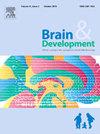Volumetric and microstructural changes in the Hippocampus and cingulum in children with west syndrome
IF 1.3
4区 医学
Q4 CLINICAL NEUROLOGY
引用次数: 0
Abstract
Purpose:
We aimed to investigate structural changes in the hippocampus using automated segmentation techniques to evaluate the anatomy and function of the hippocampus in patients with West syndrome (WS).
Methods:
The study included 48 participants (24 with WS and 24 healthy controls) aged 0‐4 years. Automated segmentation methods were used to measure hippocampal volume and evaluate diffusion tensor imaging (DTI) parameters such as fractional anisotropy (FA) and mean diffusivity (MD). Bonferroni correction was applied for multiple comparisons, setting the adjusted significance threshold at p < 0.0033.
Results:
Children with WS exhibited significantly reduced total hippocampal volume and diminished volumes in the CA2–CA3, CA4-dentate gyrus (CA4-DG), and SR-SL-SM regions compared to healthy controls (padj <0.0033). After correction, no significant differences were found in the CA1 and subiculum regions (padj >0.0033). Although initial comparisons between ongoing WS and seizure-controlled WS suggested increased volumes in several hippocampal regions in the seizure-controlled group, these differences did not remain significant after adjustment and must be interpreted with caution. Notably, patients with seizure-controlled WS displayed larger hippocampal volumes, higher FA, and lower MD values, indicating a possible link between seizure activity and structural alterations. Additionally, DTI analysis of the cingulum revealed lower FA and higher MD values in WS patients, suggesting compromised microstructural integrity.
Conclusions:
These findings emphasize the potential role of hippocampal alterations in the pathophysiology of WS and suggest that DTI parameters may serve as useful measures for monitoring disease progression and treatment response.
西综合征患儿海马和扣带体积和微观结构的改变
目的:我们旨在利用自动分割技术研究海马的结构变化,以评估West综合征(WS)患者海马的解剖结构和功能。方法:该研究包括48名年龄在0 - 4岁的参与者(24名WS患者和24名健康对照)。采用自动分割方法测量海马体积,评估弥散张量成像(DTI)参数,如分数各向异性(FA)和平均扩散率(MD)。多重比较采用Bonferroni校正,调整显著性阈值为p <;0.0033.结果:与健康对照组相比,WS患儿海马总体积显著减小,CA2-CA3、ca4 -齿状回(CA4-DG)和SR-SL-SM区域体积减小(padj <0.0033)。校正后,CA1和耻骨下区域无显著差异(padj >0.0033)。虽然在持续WS和癫痫控制WS之间的初步比较表明,癫痫控制组的几个海马区域的体积增加,但这些差异在调整后并不显着,必须谨慎解释。值得注意的是,癫痫控制的WS患者表现出更大的海马体积、更高的FA和更低的MD值,这表明癫痫发作活动与结构改变之间可能存在联系。此外,DTI分析显示,WS患者的FA值较低,MD值较高,表明微结构完整性受损。结论:这些发现强调了海马改变在WS病理生理中的潜在作用,并提示DTI参数可作为监测疾病进展和治疗反应的有用措施。
本文章由计算机程序翻译,如有差异,请以英文原文为准。
求助全文
约1分钟内获得全文
求助全文
来源期刊

Brain & Development
医学-临床神经学
CiteScore
3.60
自引率
0.00%
发文量
153
审稿时长
50 days
期刊介绍:
Brain and Development (ISSN 0387-7604) is the Official Journal of the Japanese Society of Child Neurology, and is aimed to promote clinical child neurology and developmental neuroscience.
The journal is devoted to publishing Review Articles, Full Length Original Papers, Case Reports and Letters to the Editor in the field of Child Neurology and related sciences. Proceedings of meetings, and professional announcements will be published at the Editor''s discretion. Letters concerning articles published in Brain and Development and other relevant issues are also welcome.
 求助内容:
求助内容: 应助结果提醒方式:
应助结果提醒方式:


